By Sumanth Neppalli, Decentralised.co
Compiled by: Yangz, Techub News
In 2010, Google launched a second-price ad auction system, where the highest bidder wins the ad space but only has to pay the second-highest bid.
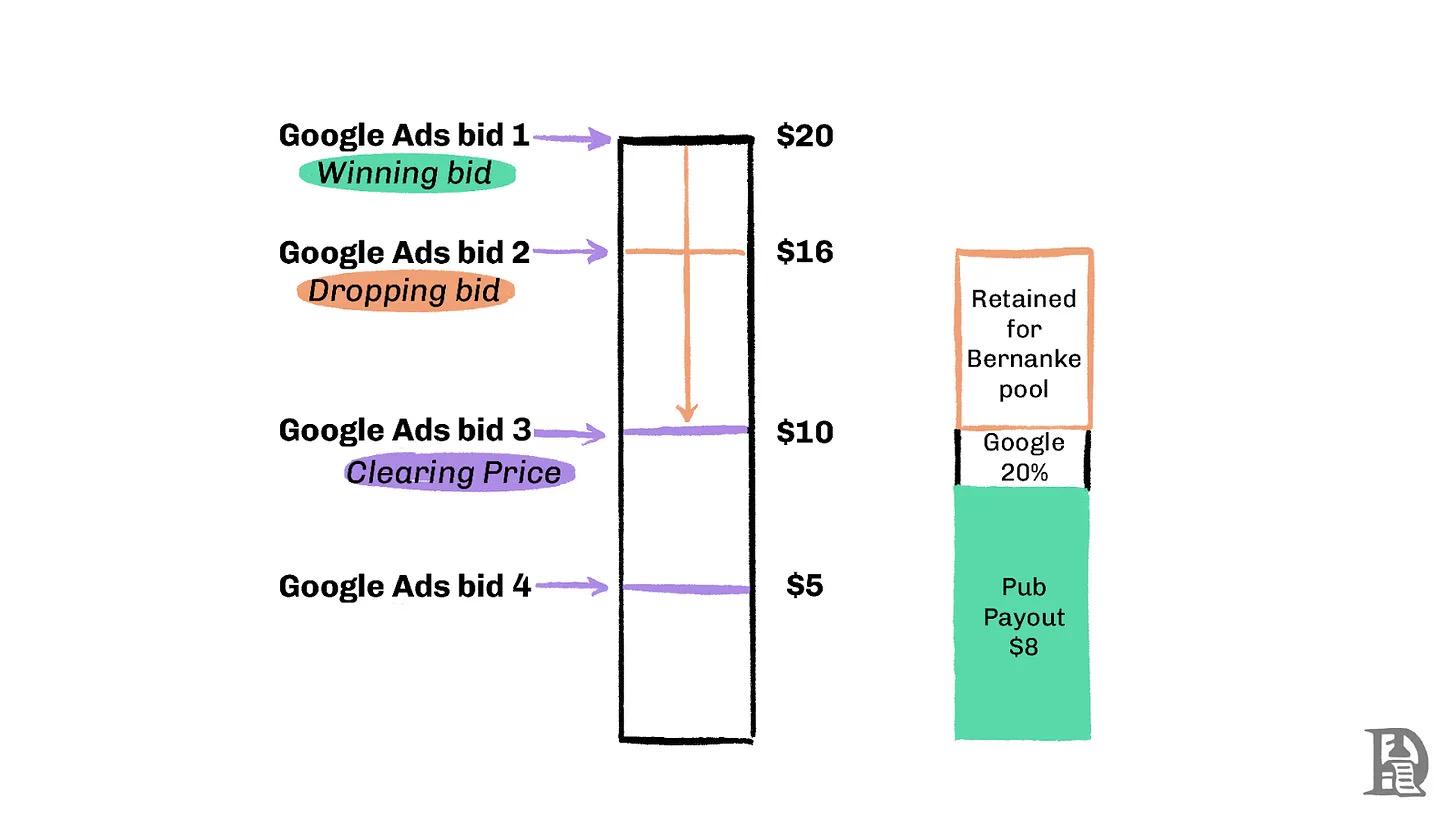
This looks like an ideal model for economists, which helps to avoid advertisers over-bidding. However, secretly, Google secretly made millions of dollars in hidden profits by manipulating the auction mechanism. For example, when the highest bid is $20 and the second highest bid is $16, the winner only needs to pay $16. However, Google actually pays the third highest price (assuming $10) to the website publisher, pocketing the $6 difference. These funds flow into a secret account called the " Bernanke Pool " and are used to achieve corporate goals such as Wall Street expectations. This operation was not exposed until the antitrust lawsuit in 2016.
Although Google switched to a first-price auction system in 2019 (settling to the publisher based on the highest bid), the lesson remains profound: when the auctioneer controls the underlying rules, even the most perfect mechanism can be distorted.
Interestingly, this is happening again in the cryptocurrency world. Blockchain is facing its own “Bernanke moment” — the maximum extractable value (MEV, i.e., the profit gained through reorganization, adding or deleting block transactions) has become the most critical yet least understood phenomenon in the cryptocurrency space. Just like Google’s hidden auction manipulation, this kind of value extraction is out of the view of ordinary users, but it affects all blockchain participants, forming a kind of “invisible tax.”
Will MEV follow in Google's footsteps and move towards shady operations and centralization, or will it evolve into a transparent decentralized system that returns profits to users? Can we design a mechanism that allows value extraction to feed back to the ecosystem instead of concentrating wealth in the hands of a few people? Let's take a deeper look below.
The physics of delay
The blockchain is a decentralized network consisting of thousands of verification nodes (validators or miners) around the world. These nodes play a dual role : they are both communication hubs that receive and broadcast transactions, and computing terminals that execute and verify transactions.
Since nodes are distributed all over the world, there is bound to be a delay in communication between validators - this is a physical bottleneck determined by the speed of light. In order to ensure that all nodes follow the same transaction order, each blockchain sets a "block time": a validator is selected through a consensus mechanism (such as proof of stake) to propose a new block, and the remaining validators accept the block after confirming that the transaction is compliant. After each block is generated, the proposal right will rotate among the validators to maintain network security. For example, Bitcoin produces blocks every 10 minutes, Ethereum has accelerated the pace to 12 seconds, Solana is trying to break the 400 millisecond limit, and L2 such as Arbitrum is challenging the ultra-high frequency range of 10-250 milliseconds.
Regardless of the length, each block time window creates an opportunity for validators to reorganize transactions for profit, rather than prioritizing user fairness. Ideally, the "first come, first served" principle should be followed, but this principle is difficult to achieve due to the global distribution of nodes. When a user initiates a transaction, it is almost impossible for all nodes to receive the transaction synchronously due to network latency. This means that even if the block construction rules are fully complied with, unfair transaction ordering (causing users to pay extra fees and MEV arbitrageurs to intercept the difference) may still be included in the block.

MEV (Maximum Extractable Value) refers to the profit obtained by block producers (miners in proof-of-work or validators in proof-of-stake) and other participants (by bribing block producers to put user transactions first) by strategically adjusting the order of transactions within a block.
MEV: A hidden and lucrative business
Assume Joel is using a DEX like Uniswap to buy ETH at $1800. He sets his slippage tolerance to 10%, meaning he can accept the price rising to $1980 by the time the trade is completed.
Joel’s transaction first goes to the mempool, a public waiting room for pending transactions, waiting to be packaged into a block. At this point, a trading robot discovers his transaction and immediately copies the order, “jumping the queue” by paying a higher gas fee (a higher gas fee is essentially a bribe to the validator to ensure that the transaction can be executed before Joel). When the robot’s buy order pushes the price of ETH on the DEX to $1,900, Joel’s transaction is finally completed at this inflated price. The robot then sells the ETH back to the fund pool at this price, making a profit from the difference (after deducting the gas fee). In the end, although Joel bought ETH, he paid $100 more, and the money went into the robot’s pocket. Similar operations are performed thousands of times a day in the cryptocurrency market.
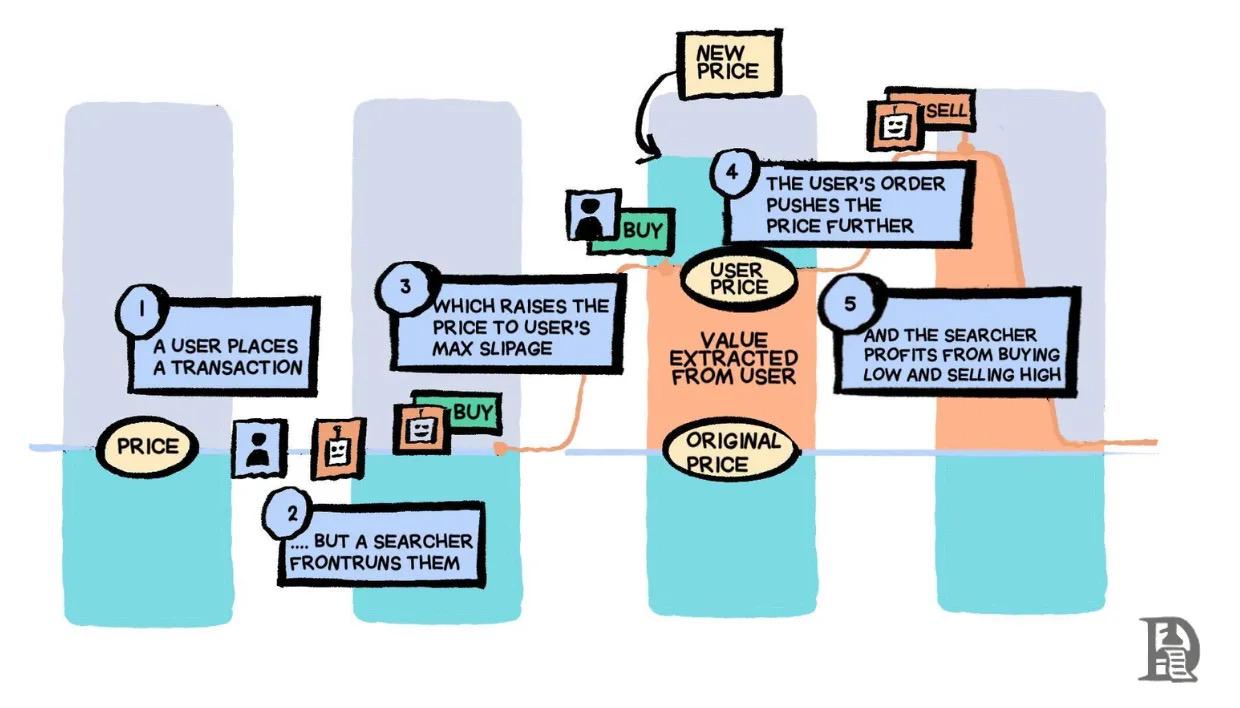
A more extreme example is that because a trader forgot to set the slippage tolerance, a robot intercepted $200,000 in profits through a single transaction. The "culprit" in this incident is jaredfromsubway.eth . By continuously paying the highest gas fee in Ethereum, the robot can always complete the operation before the transaction it wants to snipe. According to statistics, Jared has made more than $10 million in profits through this type of MEV attack.

MEV is mainly manifested in three forms:
Arbitrage trading: discover the price difference between different exchanges, buy low and sell high in the same block. For example, when ETH is quoted at $2,500 on Uniswap and $2,510 on Sushiswap, the robot can complete the buy and sell operations in the same block, making a risk-free profit of $10 per ETH. It should be noted that this type of operation is actually beneficial to the market because it promotes price convergence between platforms.
Sandwich attack: After observing Alice's large buy order in the memory pool, the robot buys first and pushes up the price, and then sells immediately after Alice completes the transaction at a high price. The robot earns the difference, while Alice suffers slippage loss. The case of Joel paying an extra $100 mentioned above is a typical sandwich attack, and this additional expenditure is ultimately converted into profit for the MEV value chain. This type of operation is obviously disadvantageous to users, causing them to pay unnecessary additional costs.
Liquidation arbitrage: In a lending agreement, when a position reaches the liquidation conditions, MEV extractors will compete to become the first liquidator to obtain rewards. For example, Saurabh borrowed 10,000 USDC with ETH worth $15,000 as collateral. When the ETH price fell and the value of the collateral dropped to $11,000, liquidation was triggered. At this time, the robot will immediately repay the loan of 5,000 USDC and obtain ETH worth $5,500 (including 10% liquidation reward), making an easy profit of $500. The impact of this type of operation is two-sided: from the perspective of maintaining the health of the DeFi system, the liquidation mechanism is necessary; but most of the benefits are ultimately obtained by the validators.
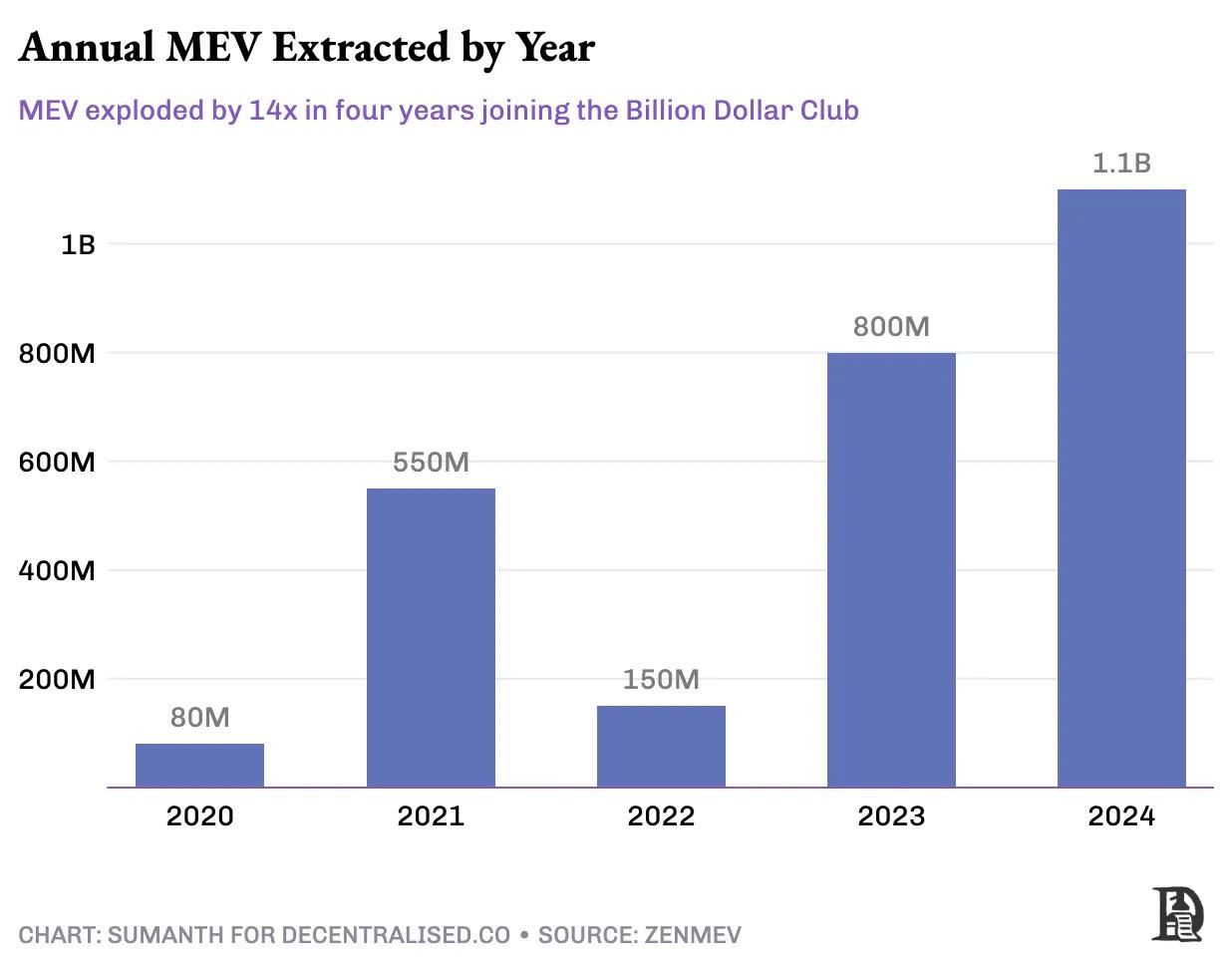
The scale of MEV extraction has doubled from $550 million in 2021 to $1.1 billion in 2024. Ethereum is still the main battlefield for MEV with its open memory pool and deep DeFi liquidity, with more than 100 active bots accounting for about 75% of MEV extraction activities. Data from the past 30 days show that sandwich attacks account for 66% of the total Ethereum MEV, arbitrage transactions account for 33%, and liquidation arbitrage accounts for less than 1%.
As on-chain transactions expand to other public chains, MEV also spreads. Solana, BNB Chain, and Ethereum Rollup networks have become hunting grounds for arbitrage robots, and even CZ has suffered a sandwich attack when exchanging tokens. In the past 30 days alone, the sandwich robot on Solana has made a profit of more than $4 million ( 24,000 SOL ), which is 50 times the profit of similar robots on Ethereum in the same period ( 80,000 US dollars ).
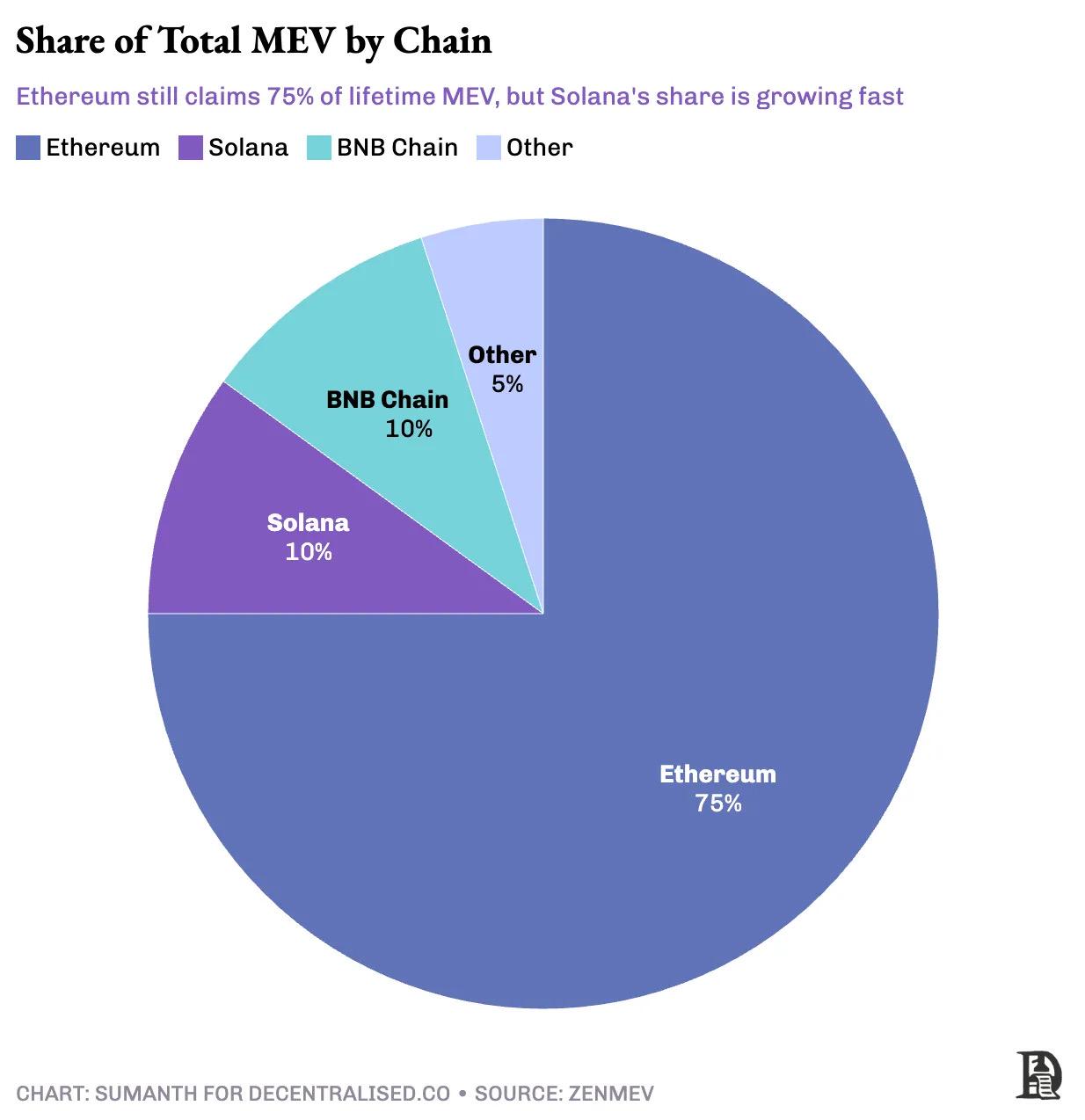
In addition, the rise of cross-chain bridges has upgraded this game to a "chain-to-chain competition". Arbitrage bots began to switch rapidly between ecosystems, chasing every dollar of potential profit. In December 2024 alone, the scale of MEV activity on Solana exceeded the $100 million mark due to market volatility caused by Trump's re-election campaign.
Last year, the total DEX trading volume was about $1.5 trillion, which means that the cost of MEV accounted for about 0.1% of the total trading volume. However, research by Frontier Labs shows that for large transactions, this proportion may be as high as 1%. Although it is easy to regard MEV as a scourge, in fact, value loss exists in all financial markets. The key question is: Can we reduce this loss? Or at least let market participants share these costs more fairly?
MEV Supply Chain
The two major privileges granted to validators by early blockchains (determining which transactions can enter the next block and controlling the order of transactions) remind me of the "dark pool" problem in "Flash Boys" . Just as stock exchanges open up privileged channels for high-frequency traders, validators can secretly collude with robots to ensure that the robots' transactions are executed before ordinary users. This "pay-to-jump" mechanism results in insiders always getting the best price, while ordinary users can only get worse prices.
To resolve this centralization risk, the Ethereum ecosystem is turning to the "proposer-builder separation" ( PBS ) solution to separate the functions of block construction and chain upload:
A user submits a transaction or high-level intent (e.g. “Exchange token A for token B at the best exchange rate”)
After the wallet processes the transaction, it is sent to the searcher/builder/memory pool through the node
Seekers scan the memory pool for arbitrage opportunities and package related transactions
Builders assemble transaction packages and hold block auctions
The validator (proposer) selects the block with the highest profit and verifies the validity of all transactions before uploading them to the chain.
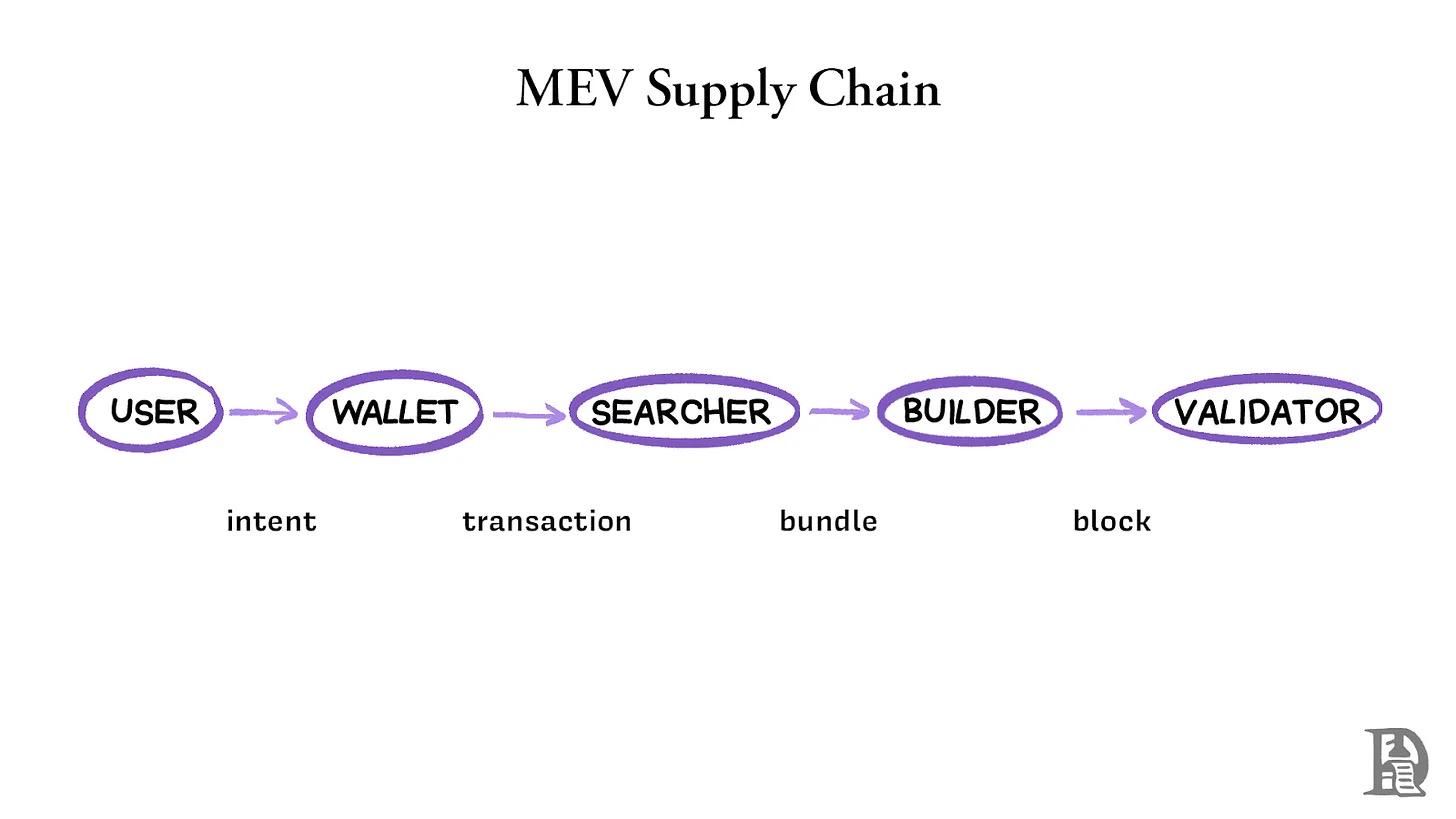
This separation of roles weakens the power of validators. They can now only choose from pre-ordered blocks, making MEV opportunities more widely distributed and forming a competitive block construction market. The most widely adopted PBS scheme is MEV-Boost developed by Flashbots, which has been adopted by more than 90% of Ethereum validators as of early 2025.
The evolution of terminology from "Miner Extractable Value" to "Maximum Extractable Value" marks that the arbitrage subject has expanded from miners to the entire ecosystem. When you click "Exchange" on a DEX, whether you use an automated market maker (AMM) such as Uniswap or an order book model such as Raydium, your counterparty is unlikely to be another ordinary user. Professional market makers behind the scenes (such as Wintermute) earn bid-ask spreads by providing liquidity. In the AMM mechanism, they earn transaction fees by injecting cryptocurrencies into the funding pool.
Trying to eliminate MEV is unrealistic, as it is deeply embedded in the economics of block time. On the one hand, arbitrage maintains price consistency between CEX and DEX, and even subsidizes network security through MEV tips; on the other hand, sandwich attacks and gas fee bidding wars force ordinary users to pay higher costs.
MEV is the inevitable product of an efficient market. As long as there is profit margin, someone will grab it. The current ecosystem favors professional searchers, block builders, and market-making robots, at the expense of ordinary traders who are front-runners, suffer additional slippage, or face liquidity transfer to unauditable "dark pools". Robots submit transactions to the memory pool at milliseconds to compete for MEV opportunities. This delayed competition not only clogs mempoll with junk transactions and wastes bandwidth, but also drives up fees, becoming an invisible tax on every exchange. The key to the problem is not to eliminate MEV, but to determine who gets these benefits and under what conditions.
Strategies to reduce MEV
To deal with the MEV problem, the industry has explored four main strategies : hiding, exploiting, minimizing, and redirecting. Each solution has different trade-offs between efficiency, fairness, and technical complexity.
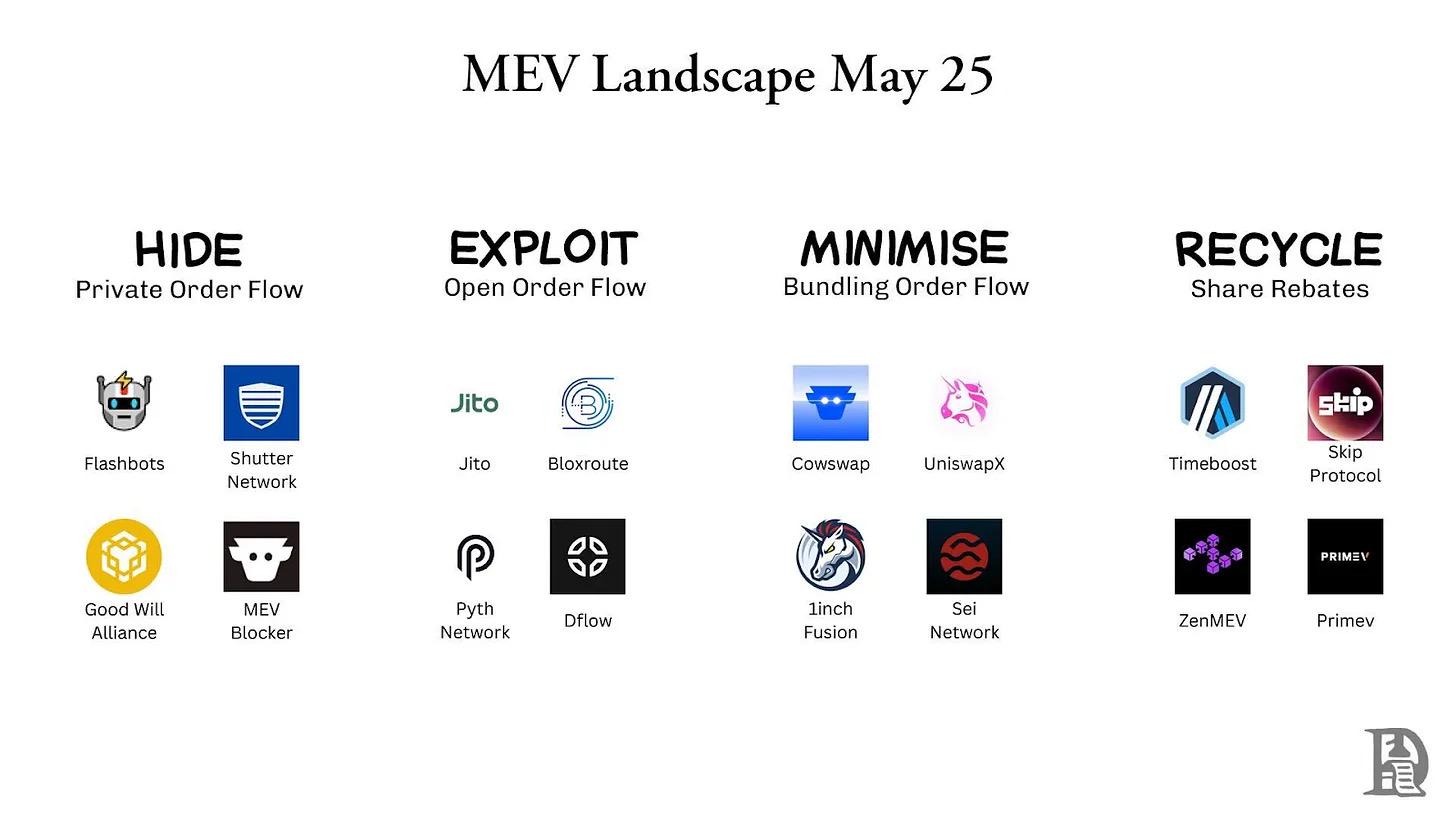
MEV hidden strategy
The simplest solution is to keep transaction information hidden until it is packaged. Tools such as Flashbots Protect and Cowswap MEV Blocker are built for this purpose. With these services, transactions are sent privately directly to block builders instead of being publicly exposed in the memory pool. Arbitrage bots cannot even detect the existence of the transaction until it is executed.
However, the cost of this strategy is that you have to wait for the validator who adopts the service to be selected as the proposer. Taking Flashbots Protect as an example, this process may take up to 6 minutes (but since the transaction does not enter the public memory pool, the user can cancel the unexecuted transaction at any time). Market makers and large traders often use such services to avoid early exposure of trading strategies. To date, the transaction amount processed by Flashbots Protect has exceeded 43 billion US dollars.
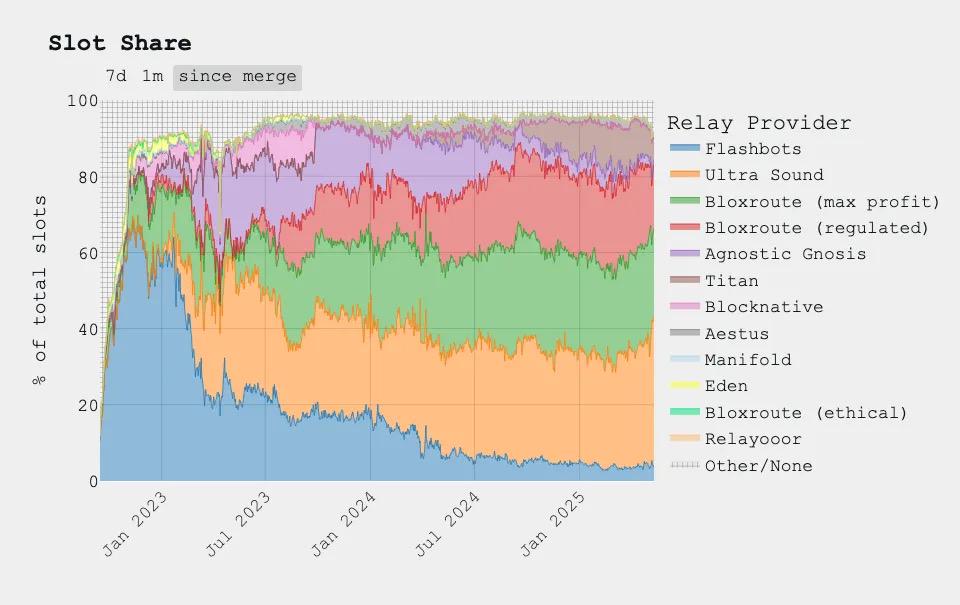
I have reservations about these centralized privacy solutions because they always remind me of dark pool trading in traditional finance. Mechanisms that were originally designed to protect users often end up evolving into "Robinhood-style" insider privileges.
Currently, Flashbots and Beaverbuild are developing hardware solutions based on Trusted Execution Environment (TEE), which can prove its honesty through cryptography. This direction is promising, but has not yet been verified in large-scale practice.
In addition, some communities have begun to take proactive actions. The BNB community voted to form the Good Will Alliance , requiring validators to only accept blocks submitted by builders that comply with the MEV specification. These builders will filter out transactions that are exploitative of MEV, and the system will punish validators who do not adopt compliant infrastructure.
MEV Exploitation Strategy
Rather than eliminating MEV entirely, some protocols attempt to weaponize arbitrage competition through private auction mechanisms, allowing hunters to check and balance each other.
Imagine Joel wants to exchange 100 ETH for USDC. In the traditional AMM model, this transaction will enter the public memory pool and be exposed to the risk of sandwich attacks. But in the RFQ model, Joel sends the exchange request to the market maker network: suppose Wintermute quotes $2,000 per ETH and DWF Labs quotes $2,010. Joel will accept the better offer and trade at $2,010, completely avoiding the risk of slippage and front-running.
Behind the scenes, each market maker is calculating the potential profit of this transaction. They provide the best quote by mobilizing liquidity from multiple sources, while suppressing competitors while maintaining profits.
However, the RFQ system has inherent defects and requires a 24/7 online market maker network to respond in real time. If there are not enough participants, the system will appear sluggish and users may miss opportunities due to market fluctuations. RFQ is more used in areas with insufficient liquidity, such as fixed-income bonds. More importantly, if the market maker alliance lacks credibility or decentralization, RFQ may become a new insider club.
To this end, Pyth developed the off-chain market Express Relay on Solana, allowing all protocols to access a competitive market maker pool. DeFi applications can outsource transaction execution and minimize MEV without having to connect to each market maker individually.
On the other hand, Jito, by choosing another path, now controls more than 90% of Solana's staked SOL. We have reported that Jito tried to build a memory pool on Solana, but gave up because the attacker spent $300,000 to buy block priority. Now Jito holds an off-chain auction every 200 milliseconds to screen the most profitable transactions and package them into the next block. Users pay a "priority fee" to purchase a fast channel to prevent MEV attacks, and these fees constitute nearly half of Solana validators' income.
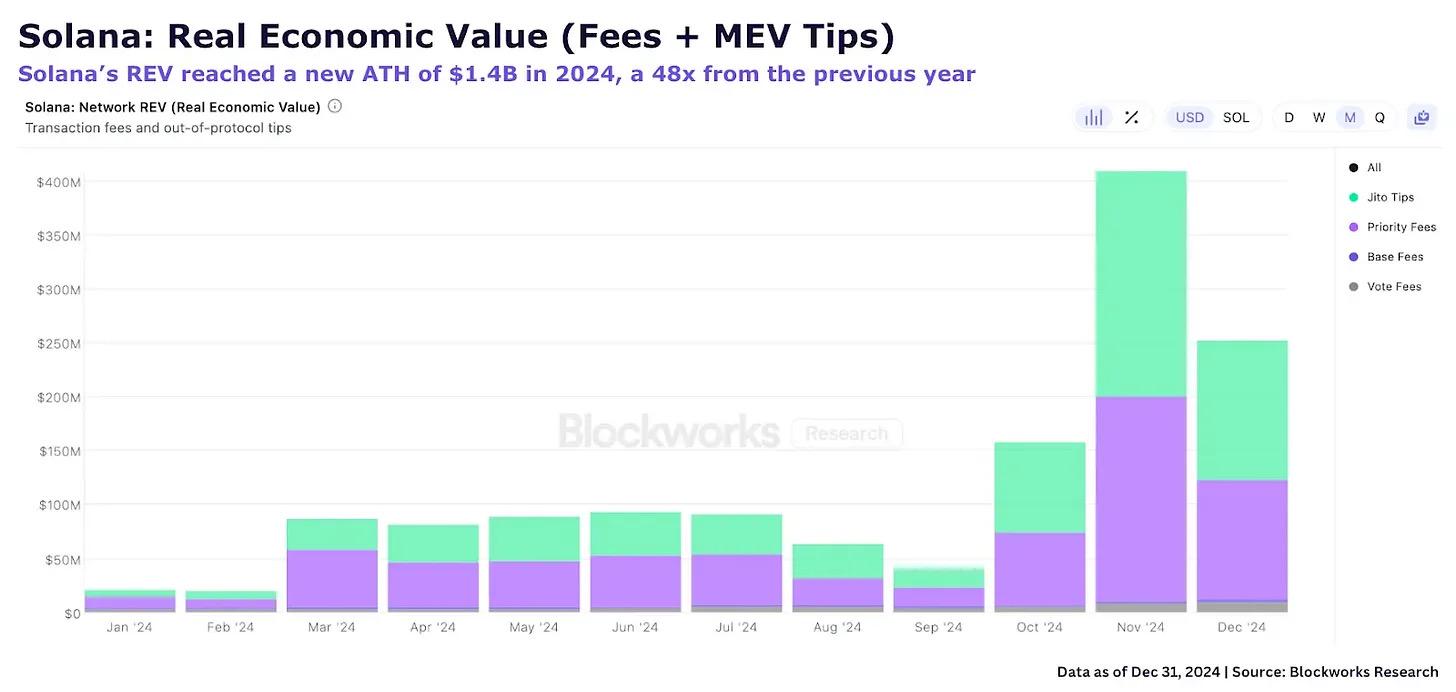
MEV Minimization Strategy
This scheme goes a step further than order flow auctions, radically reducing the total amount of MEV that can be withdrawn through clever auction design.
The traditional transaction-by-transaction processing model creates an opportunity for MEV - robots can observe each transaction and insert arbitrage operations. The batch trading protocol packages multiple orders and executes them simultaneously at a unified price. Since all orders are grouped into the same batch and settled at the same price, MEV robots cannot profit from sorting or time differences.

The batch trading mechanism pioneered by CoWSwap is based on a simple insight: when user A wants to exchange ETH for DAI, and user B wants to exchange DAI for ETH, the two parties can directly pair up and trade without going through an exchange. The protocol collects trading intentions within a short time window, prioritizes these natural hedging needs, and then uses on-chain liquidity to process the remaining transactions.
Even better, traders don’t need to be deeply versed in crypto market structure. When using CoWSwap, users don’t have to adjust complex parameters such as slippage tolerance or cross-pool routing, they just need to declare their trading needs. Solvers (professional market makers who act as auction settlers) will compete to provide the best quotes, and all traders in the same batch will enjoy the same asset price.
At present, CoWSwap has processed about $100 billion in transactions. Its leading solver Barter (market share of about 15%) has processed more than $11 billion in transactions through the protocol, and is showing a steady growth trend. This growth confirms the effectiveness of the batch auction mechanism in reducing MEV. The success of solvers such as Barter relies on price competition in a fair and unified execution environment, rather than transaction timing exploitation.
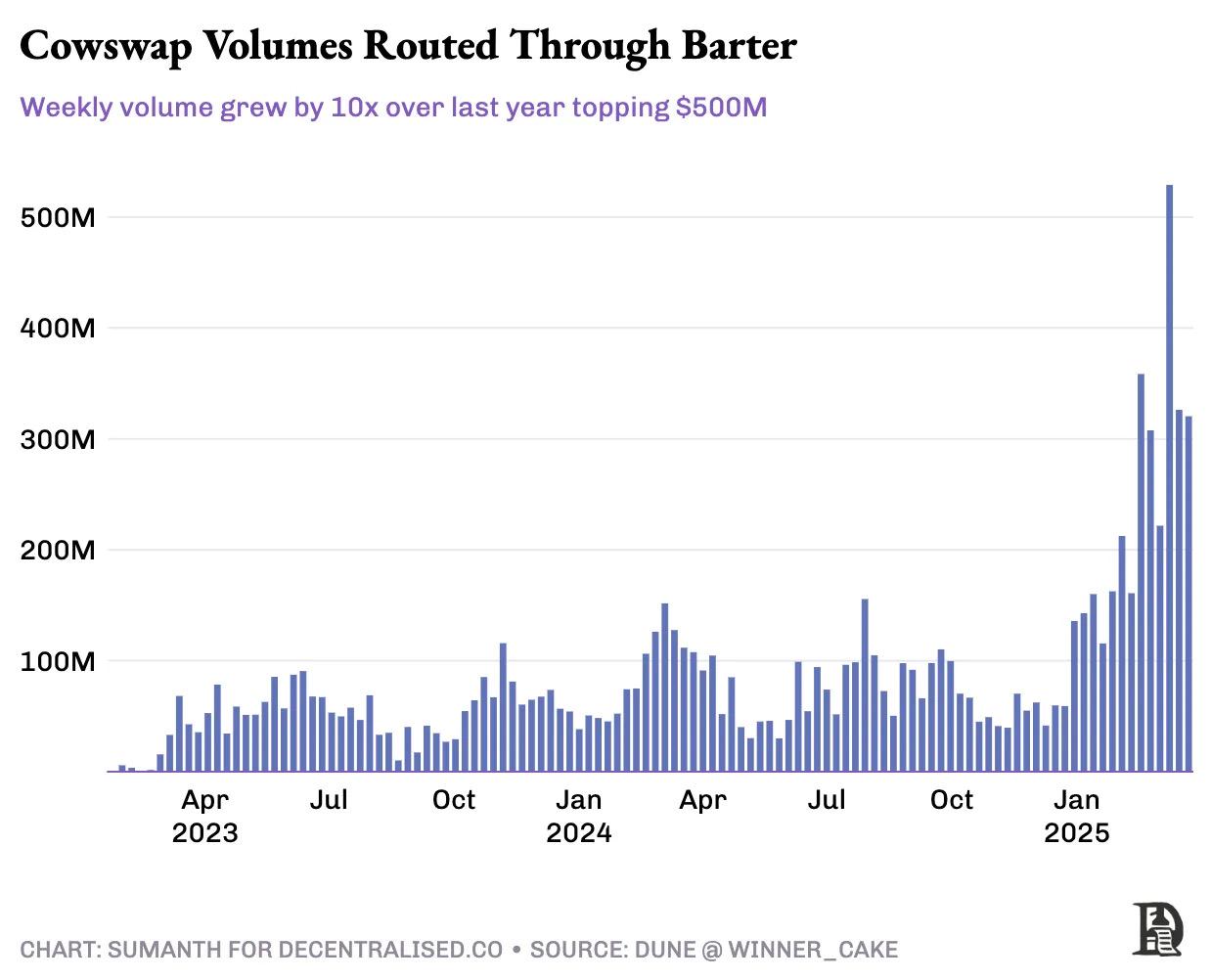
This mechanism coincides with the research of Eric Budish, a professor at the University of Chicago Booth School of Business. He believes that batch auctions once per second can eliminate the speed competition of high-frequency trading: "Batch processing also solves the prisoner's dilemma of continuous order book markets and distributes welfare gains to investors."
In the cryptocurrency space, the traditional continuous order book model (such as used by most DEXs) rewards the fastest, causing traders to continuously invest in better hardware, faster robots, or more direct node connections, but these investments do not help improve the user experience. Batch auction logic like the one used by CoWSwap executes all transactions within a fixed time window at a uniform price, making the speed factor invalid and truly focusing on price discovery and user value.
MEV redirection strategy
Some innovators have taken a more pragmatic approach: if MEV extraction can’t be prevented, why not capture it and return the profits to the community?
Arbitrum's TimeBoost is a perfect example of this concept. The protocol sets up a 200 millisecond "fast lane" and allocates access rights every minute through a sealed bid second-price auction. Just like the VIP checkout lane at a supermarket, the highest bidder can prioritize transactions within a short time window. Searchers who want their transactions to be prioritized can bid for this priority lane by predicting the MEV potential within the 60-second window period without having to participate in a chaotic gas fee bidding war.
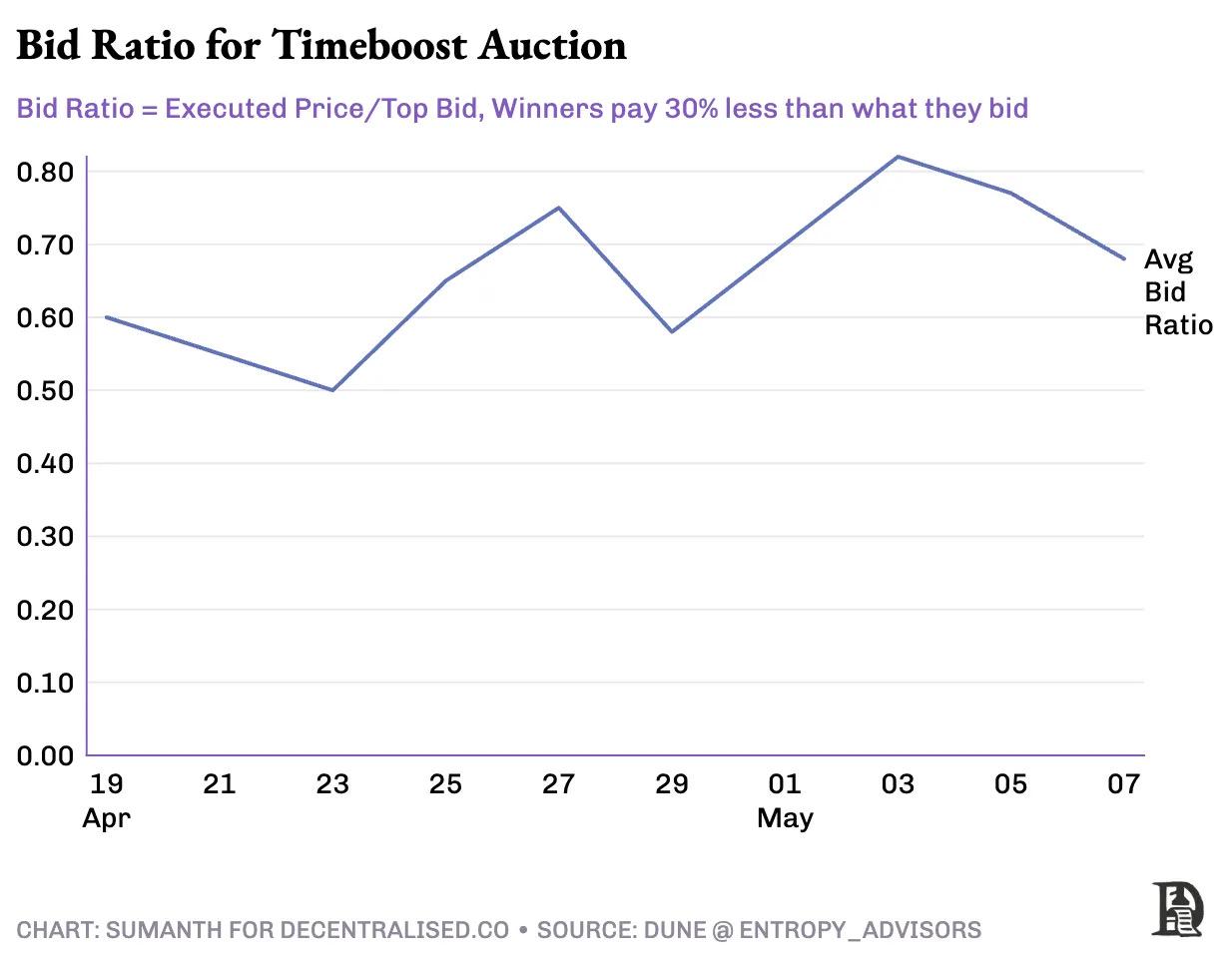
This mechanism completely changes the situation for attackers, who now miss out on the opportunity to extract MEV profits from anyone using the fast track. Since the auction rotates frequently among all searchers, it is almost impossible to form an extraction monopoly. This system transforms MEV from an implicit tax to a public good, with 97% of TimeBoost's revenue going to the ARB DAO treasury, with an estimated annual revenue of $30 million.
In addition, Jito mentioned above also adopts a hybrid solution, where 3% of the transaction priority fee will be redistributed to Jito DAO and JitoSOL stakers.
How to choose the MEV auction mechanism
There are five core auction designs in the MEV field today. Let’s take the example of three participants (searchers/solvers/builders) bidding for block space, assuming that their respective private valuations are $100, $80, and $60 respectively.
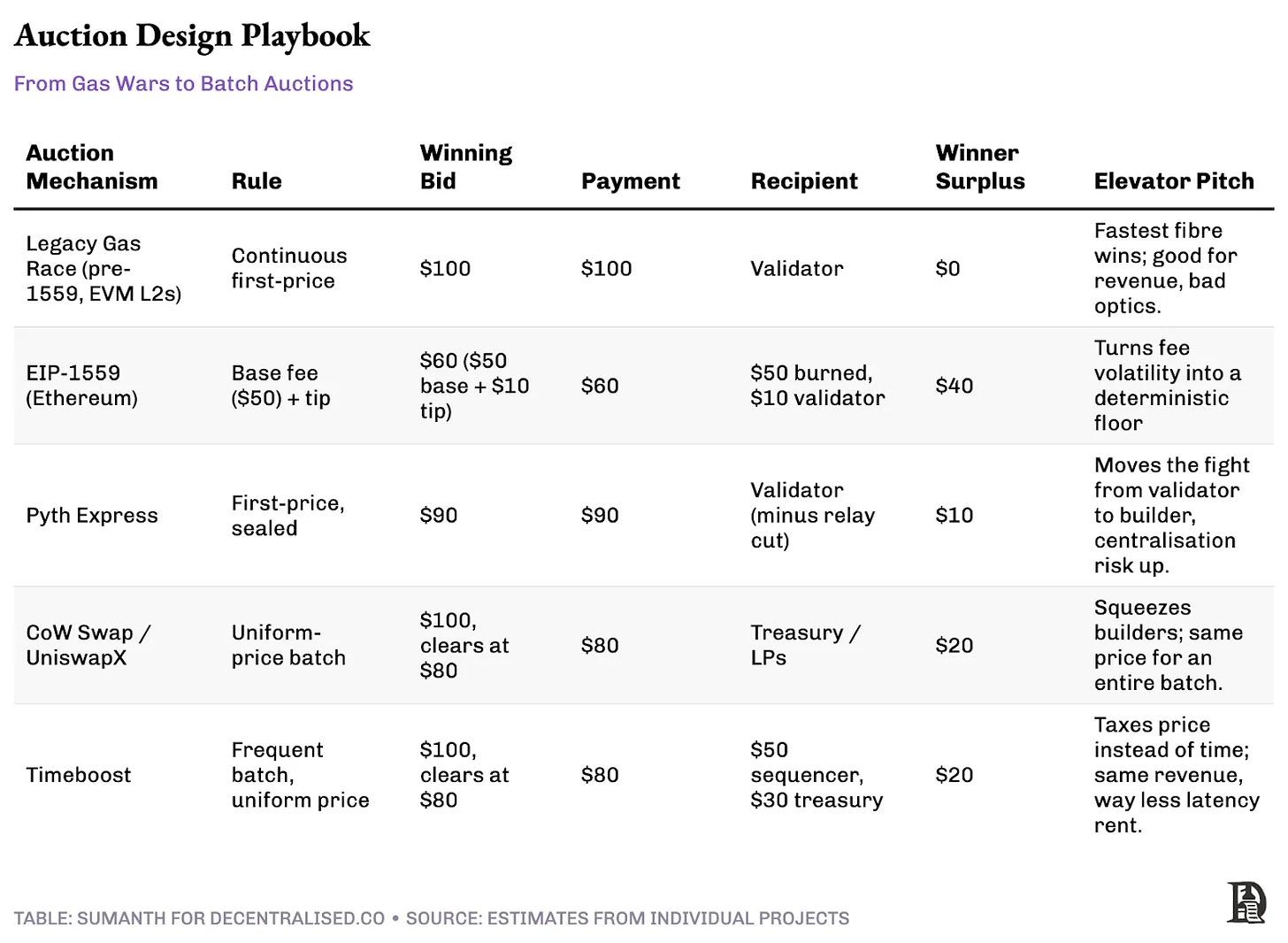
There is no one-size-fits-all answer to the so-called "optimal" auction solution. The key depends on the goals of the agreement:
Maximizing Revenue : Choose Sealed First-Price Auction
Community credibility and user stickiness : Adopting a tiered mechanism similar to EIP-1559’s “base fee + intention unified price”
Breaking the monopoly of MEV extraction : Implementing high-frequency batch auctions to let price, not speed, determine the outcome
Speed-sensitive scenarios such as DEX : Private order flow is the best solution
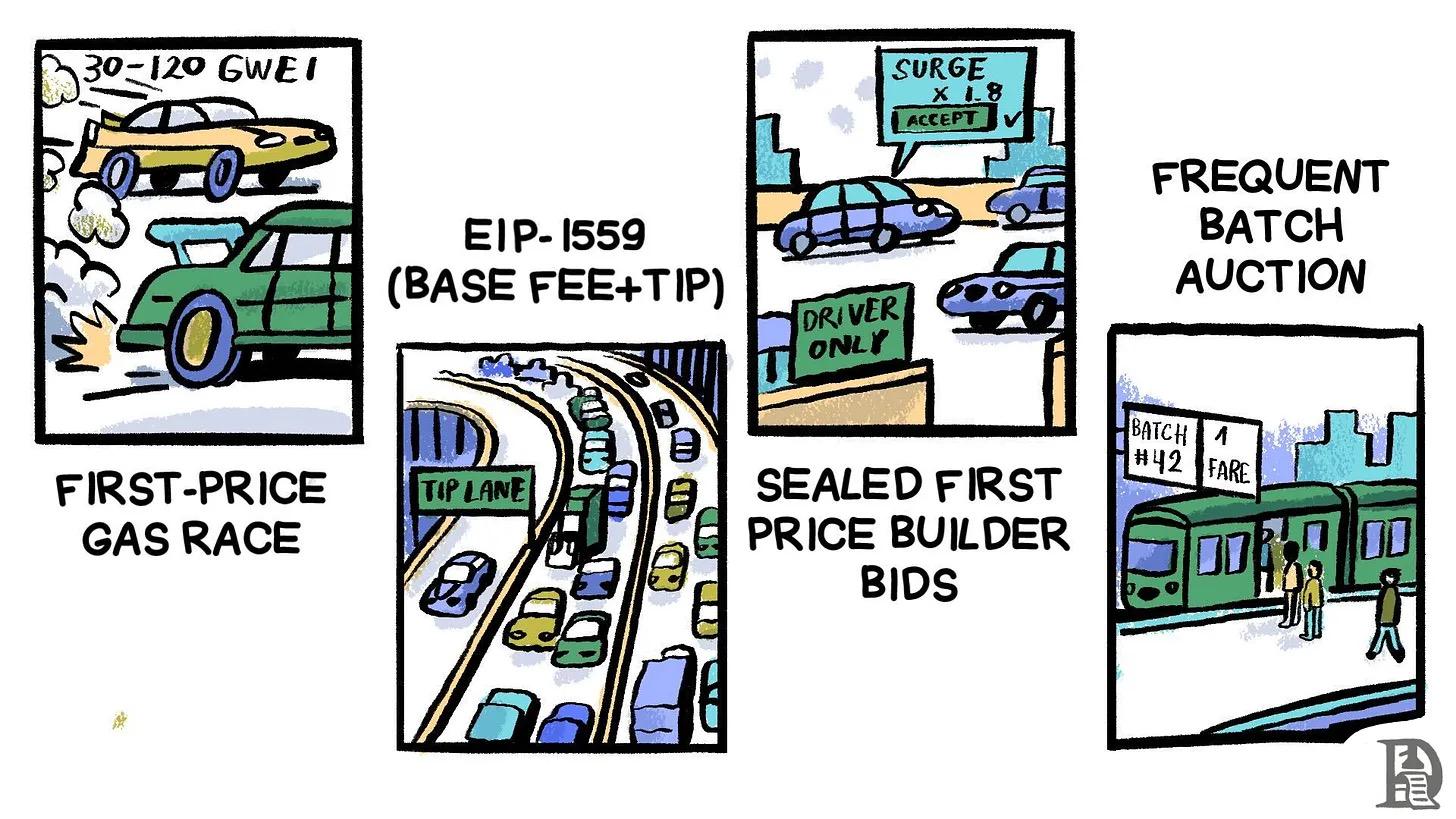
The road ahead
The strategy of hiding order flow and auctioning it to private market makers sounds familiar, and the story of Wall Street's dark pool is repeating itself on the chain. As cryptocurrencies become increasingly institutionalized and integrated with traditional auction models, this trend may accelerate.
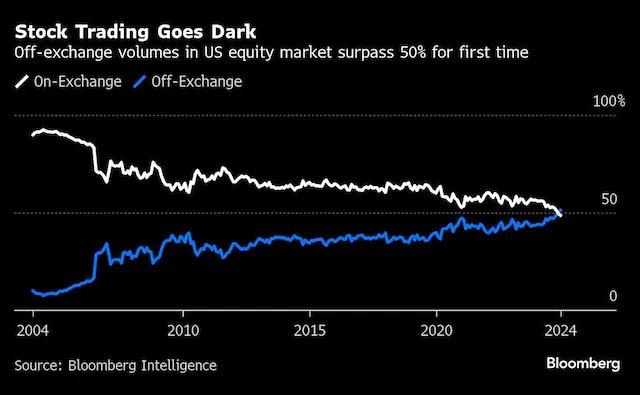
Only the best teams can play the role of searcher, builder or solver. This technological advantage will accumulate over time, giving large institutions with cutting-edge infrastructure and machine learning algorithm development teams a structural advantage. Traditional market makers such as Morgan Stanley and Goldman Sachs may also join the battle.
At present, various chains have begun to express their positions on the MEV issue: Solana, which pursues ultra-low latency, tends to adopt a private order flow mechanism similar to Nasdaq's speed advantage; Ethereum uses PBS and MEV-Boost to achieve democratic access; and other public chains are exploring new directions based on their own architectural characteristics.
In my opinion, the most groundbreaking innovation is likely to happen on Layer 2. As Arbitrum TimeBoost demonstrates, L2 is freer to experiment with various auction designs and value distribution models.
The composable, permissionless nature of DeFi creates a mechanism iteration speed that far exceeds that of traditional markets. Although high-frequency batch auctions have been hotly discussed since 2015, they have been hindered by regulatory restrictions ; on-chain, projects like Sei can implement such innovations in just a few months. In addition, another solution is to establish a decentralized market maker network. In the future, there may be a "builder reputation market". Through systems such as Eigenlayer, market makers can prove their integrity by staking tokens, and protocols can be screened based on transparent reputation scores.
Please don't think these ideas are too idealistic. You should know that 20 years ago, no one believed that millisecond microwave towers would reshape the trading order of the S&P 500. As long as interests exist, capital will find a way out.





